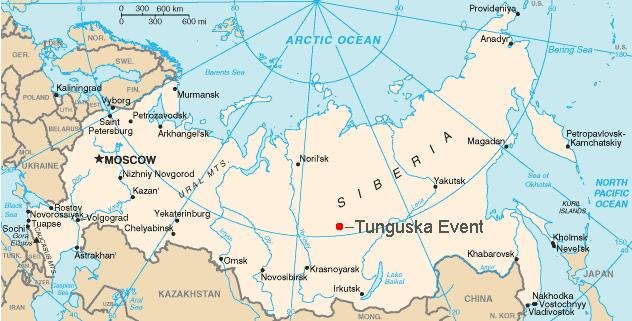1 of 4 | Siberian location of the Tunguska event
When astronomers consider cosmic collisions having impacts on the Earth, their eyes turn either to events of the distant past -- like the asteroid impact 65 million years ago that may have pushed the dinosaurs to extinction -- or to the uncertain future, as telescopes and satellites search for so-called Near Earth Objects that might someday represent a collision threat to our planet.
But there are at least a couple of recent examples -- one well known, one somewhat less so -- of cosmic interlopers that survived a plunge through our planet's atmosphere to leave their mark on the Earth's surface.
Most people are aware of the Barrington Crater, commonly known as just the Meteor Crater, in the desert of northern Arizona.
Generally considered the best-preserved crater on Earth, it was formed about 50,000 years ago when a nickel-iron meteorite roughly 50 yards across slammed into the Earth's surface at more than 28,000 mph, leaving the 4,000-foot crater visible today.
On a geologic time scale, of course, 50,000 years counts as almost yesterday.
But if that's the case, then an event that occurred in central Siberia in 1908, which has astronomers puzzled and engaged in furious debate about its particulars, could justifiably be described as having "just happened."
Early in the morning of June 30 in that year, in the area near the Podkamennaya Tunguska River, a number of people in the sparsely inhabited area reported seeing a giant fireball descending toward the earth.
The object -- the debate among scientist is evenly split between it's being a comet or an asteroid -- apparently never reached the ground but exploded in a violent air burst 3 to 6 miles above the ground.
But if the object never reached the ground the effects of the explosion certainly did, with an energy estimated at 10 megatons to 15 megatons of TNT, about 1,000 times more powerful than the atomic bomb dropped on Hiroshima in World War II.
The explosion toppled trees like snapped twigs, leaving an estimated 80 million trees flat on the ground in an area of more than 800 square miles.
A shock wave scientists estimate would have registered 5 on the Richter earthquake scale reportedly threw people to the ground and shattered windows hundreds of miles away.
However, because of the extreme isolation of the Tunguska region and the upheavals preceding World War I and the Russian Revolution, it was more than 10 years before a dedicated scientific research team visited the area.
Their main goal was to find an impact crater, and they were surprised when none was found.
Instead, at the center of the devastated area they found scorched and burnt trees, surprisingly standing upright, and in all directions away from this central point trees were knocked down, everywhere facing directly away from the center of the event.
It was the lack of any sort of impact crater that led scientists to suggest the object never reached the ground and that all damage seen in the area was the result of the huge explosion above the region.
With no impact crater scientists were unable to suggest a possible size for the comet or asteroid or meteor fragment that made the Earth its target on that early 20th century morning.
But the explosion, easily of a magnitude capable of destroying a large urban area, must give present day astronomers momentary pause as they scan the skies for other cosmic vagrants that might someday assume a path through our solar system that puts the Earth squarely in their sights.















